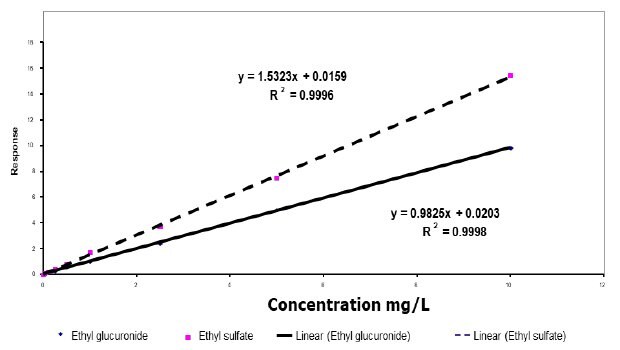Determination of Ethyl Glucuronide and Ethyl Sulfate in Urine using LC-MS/MS
Dr Patrik Appelblad, Senior Principal Scientist Advanced Analytical R&D, Merck Life Science
Overview: Ethyl Glucuronide (ETG) and Ethyl Sulfate (ETS) as Ethanol Biomarkers
Ethyl glucuronide (EtG) is a metabolite of ethyl alcohol that is formed in the body by glucuronidation following exposure to ethanol, for example by drinking alcoholic beverages. The usefulness of EtG as a recent alcohol consumption biomarker has been studied widely.
A disadvantage of the test is that because EtG can be detected in samples at very low levels, it can also show positive results following exposure to alcohol from non-beverage sources, or incidental exposure, leading to false-positive results. It has been found that EtG can only be formed after alcohol ingestion and is not formed endogenously. Therefore, the presence of EtG is definitive evidence of alcohol intake prior to post-mortem investigations. However, negative results of EtG should be interpreted with caution as false-negative results may be obtained. However, as there is a time lag between alcohol present in blood and EtG production any results should be interpreted with caution as false-negative results may be obtained if death happened shortly after alcohol consumption.
The stability of EtG has been brought into question after it was found that it can be degraded by bacteria. For this reason, ethyl sulfate (EtS) has been introduced as a complementary marker with EtG due to its stable pattern and resistance to bacterial infection; the presence of EtG and EtS provides strong evidence of recent alcohol consumption. An alternative marker for ethanol intake is phosphatidylethanols (PEth), a group of phospholipids formed only in the presence of ethanol via the action of phospholipase D.
EtG and EtS are promising biomarkers because they are phase two ethanol metabolites and their excretion profiles have been studied and documented. The following method was aimed at developing and validating an LC-ESI-ion trap-MS/MS method for identification and quantification of EtG and EtS as ethanol biomarkers from urine samples.

Figure 1. The chemical structures of ethyl glucuronide (EtG) and ethyl sulfate (EtS)
The experimental conditions for EtG and EtS analysis in urine samples is given in Table 1, LC gradient condition in Table 2, and performance data in Table 3.
Chromatograms for EtG and EtS, and corresponding internal standards, are shown in Figure 2.

Figure 2. MS/MS performance data for EtG and EtS analysis.
Sample Preparation
- Following the addition of pentadeuterated internal standards for EtG and EtS, 200 µL of acetonitrile was added to 0.1 mL of urine and centrifuged at 10,000 rpm.
- The supernatant was then evaporated before reconstituting with 100 µL of initial mobile phase prior to LC-MS/MS analysis.
The full procedure can be found in the paper ‘Direct Determination of Ethyl Glucuronide and Ethyl Sulfate in Postmortem Urine Specimens Using Hydrophilic Interaction Liquid Chromatography-Electrospray Ionization-Tandem Mass Spectrometry’1

Figure 3. Ethyl glucuronide (EtG) and ethyl sulfate (EtS) calibration curves
Conclusions
A Liquid Chromatography (LC)-electrospray ionization (ESI)-ion trap-tandem mass spectrometric (MS) method was developed and validated to identify and quantify EtG and EtS as ethanol biomarkers in urine samples. The method provides good chromatographic separation, with adequate peak shapes for easy data interpretation. It provides baseline separation of the two biomarkers in less than seven minutes, and with a low limit of quantitation (LOQ).
References
如要继续阅读,请登录或创建帐户。
暂无帐户?